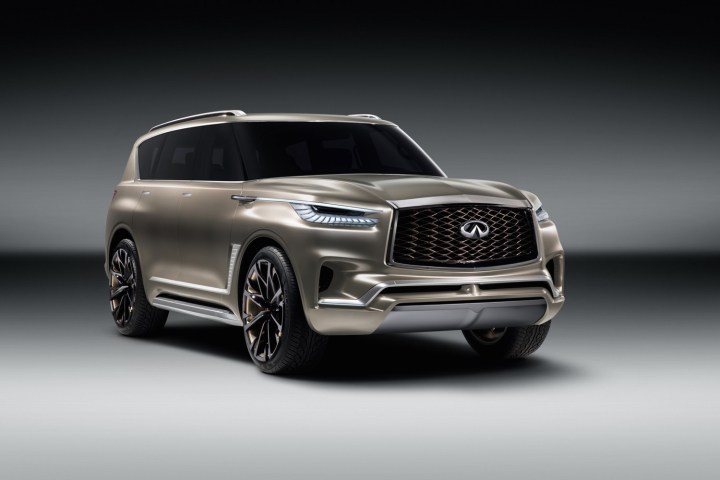
Debuting ahead of the 2017 New York Auto Show, the Infiniti QX80 Monograph concept previews the next version of Infiniti’s QX80 full-size SUV. Infiniti won’t say exactly when the next QX80 will arrive, but when it does you can bet the big SUV will feature some styling elements from this concept.
The Monograph retains much of the current QX80’s boxy, traditional SUV styling, but with some more unorthodox elements that bring it closer to Infiniti’s cars and crossovers. The more sculpted grille and headlights show DNA from the Q60 coupe and QX30 pseudo-crossover. The front bumper is more aggressive than anything currently seen on large luxury SUVs, with massive side air intakes and a lower element that juts out from the rest of the front end, giving the QX80 a bad case of underbite.
It will be hard for anything on the New York Auto Show floor to rival the QX80 Monograph when it comes to bling. The SUV concept rides on 24-inch wheels, with rims that wrap around the tires to give the appearance of 26-inchers. A more subtle touch is the pair of rearview cameras in place of exterior mirrors. That isn’t allowed by U.S. regulations, although carmakers wish it was, owing to the potential aerodynamic benefits.
The current QX80 shares a platform with the Nissan Armada, and both models stem from the Nissan Patrol sold overseas. While both the QX80 and Armada are marketed more as luxury cruisers in the vein of the Cadillac Escalade or Lincoln Navigator, the Patrol has built a reputation over several decades as a competent off-roader. It’s basically Nissan’s equivalent of the Range Rover.
While many customers likely cross-shop the QX80 with Land Rover’s flagship, it’s unlikely that Infiniti will start emphasizing off-road ability. Infiniti did not release any mechanical specifications for the QX80 Monograph, as it wants to keep the emphasis on the design. That design will likely transition to the next-generation QX80 production model Infiniti also said it will continue to use the “Monograph” name in the future.
Update on 4-11-2017 by Stephen Edelstein: Added more photos and design details


